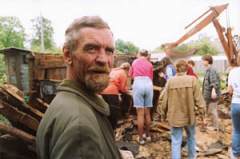
PIKKUKADUN ELÄMÄÄ - NÄYTÖS KAKSI
 Ohjaaja Ivar Seleckis ja käsikirjoittaja Talivaldis Margevics kuvasivat kymmenen vuotta sitten Latvian pääkaupungissa Riikassa dokumentin, joka kertoi yhden pikkukadun ihmisistä ja heidän kohtaloistaan. Dokumentti keräsi palkintoja ympäri maailmaa.
Ohjaaja Ivar Seleckis ja käsikirjoittaja Talivaldis Margevics kuvasivat kymmenen vuotta sitten Latvian pääkaupungissa Riikassa dokumentin, joka kertoi yhden pikkukadun ihmisistä ja heidän kohtaloistaan. Dokumentti keräsi palkintoja ympäri maailmaa.
Kymmenen vuoden aikana Latviassa on koettu poliittisesti paljon ja talouselämäkin toimii enemmän eurooppalaiseen malliin. Myös 800 metrin mittaisen riikalaiskadun ihmisille on tapahtunut paljon, vaikka elämä tuntuunkin etenevän melko verkkaisesti. Junanradan halkaiseman kadun entistä elämää kuvastaa keskelle rataa ruostumaan jätetyt vaunut. Uutta aikaa muun muassa pari uusrikkaiden linnamaista kotia ja musta mersu.
"Ehkäpä palasimme velvollisuudentunnosta. Ehkäpä nostalgian vuoksi. Ennen kaikkea halusimme tietää, mitä ystävillemme kuuluu", tuumailee ohjaaja.
Dokumenttiprojektissa esitettävä Pikkukadun elämää - näytös kaksi kietoo katsojan raukean elämänmenon leppoisuuteen. Siinä on mieliharmia, surua ja vähän naapukinaakin. Enemmän kuitenkin iloa, selviytymistarinoita ja katujuhlia.
Elokuva etenee itsenäisesti viitaten mustavalkoisin kuvin menneeseen kuin valokuva-albumia selaillen. Pääosissa ovat Daiga, jonka omat sukulaiset hääsivät kymmenen vuotta sitten vastasyntyneen, mutta isättömän pojan kanssa kodistaan. Nyt asiat ovat mallillaan. Sen sijaan Aldiksella, hautakivien tekijällä on murheita: hänen melko uusi myymälänsä on tuhottu. Mutta Jumalan avulla kaikki onnistuu. Sitten on vielä paljon muita tarinoita. Sitä tavallista pikkukadun elämää.
- Ohjaaja: Ivar Seleckis
- Tuotanto: EDFS, Latvia, 1999
In English In English In English
NEW TIMES AT CROSSROAD STREET
By Aija LiceOn July 16 the cinema Riga invited filmgoers to the premiere of a new film. The documentary Crossroad Street having won three prominent prizes in late 80s (including the best European documentary award) has now got its sequel New Times in Crossroad Street. The film crew is the same as before - the script-writer Talivaldis Margevics, the director and camera-man Ivars Seleckis, the editing director Maija Selecka, the composer Ivars Vigners...
 The original Crossroad Street was shown in the same cinema two days ago. Luckily, I was not "he only viewer, though the people in the house could be counted on the fingers of one hand.
In contrast, New Times in Crossroad Street was shown in a crowded hall, additional chairs having been brought in, and received unprecedented cheers from Latvian film goers, thus honouring the first film as well.
If Crossroad Street had aroused purely human interest in the further course of lives of its subjects, the New Times ... satisfied this interest thoroughly. The big 'Why?' brought up by the first film turned into an equally big, unsolvable and doomed "That's why, that's why...'
The original Crossroad Street was shown in the same cinema two days ago. Luckily, I was not "he only viewer, though the people in the house could be counted on the fingers of one hand.
In contrast, New Times in Crossroad Street was shown in a crowded hall, additional chairs having been brought in, and received unprecedented cheers from Latvian film goers, thus honouring the first film as well.
If Crossroad Street had aroused purely human interest in the further course of lives of its subjects, the New Times ... satisfied this interest thoroughly. The big 'Why?' brought up by the first film turned into an equally big, unsolvable and doomed "That's why, that's why...'
Against the background of the face-lifted center of present-day Riga, the former Crossroad Street appeared as a peculiar world coming from Italian neo-realism. However, it made one acutely aware of the fact that it is just one separate tiny island in the vast Latvian archipelago of numerous similar islands. At present, this life-style is not so pure any more. The old neo- realism has merged together with the banal present-day consumerism and the eclectic ideas about sunny life borrowed from French Louises.
The new film develops the original theme successfully, though in a somewhat different, impartial way. There appears strange 'we and they' contra position in the attitude towards the old acquaintances.
The new world is not discovered again, the observation is naturally continued. However, there is sometimes unneeded biassed attitude towards the changes time has brought on a smaller scale (awkward, obtrusive interrogation of Daiga, the only one of the former ordinary Crossroad Street residents who is now living on the sunny side of the street) and perplexed bewilderment when facing large-scale changes. Indeed, how could one fit the seemingly alien figure of Plumitis into this doomed valley of grief?
The new film appears to be more alienated. Perhaps it's a sign of continuous progress of our life and shows that such 'crossroads streets' belong to the past? In fact, the life in Crossroad Street has changed so little that it is easy to perceive it as anachronism if you are fortunate enough not to live there yourself. There are numerous striking scenes in the film: the one with the sufferer fellow Osis, the horse-reddish brewers, the nice guy Tolik and his mother. The philosopher-pastor and stone mason Aidis is a character fit for a feature film.
Perhaps this awkward feeling of alienation is my own. Indeed, from what viewpoint should I look at Crossroad Street where life is the same as everywhere in Latvia, whether you waist it or not. And the feeling of perplexity finds its proper place alongside the dance of the air-balloon. Perhaps it's one of the highest merits of the film.
- Director: Ivar Seleckis
- Production: EDFS, Latvia, 1999

Päivitys: 14.9.2000 U.E.